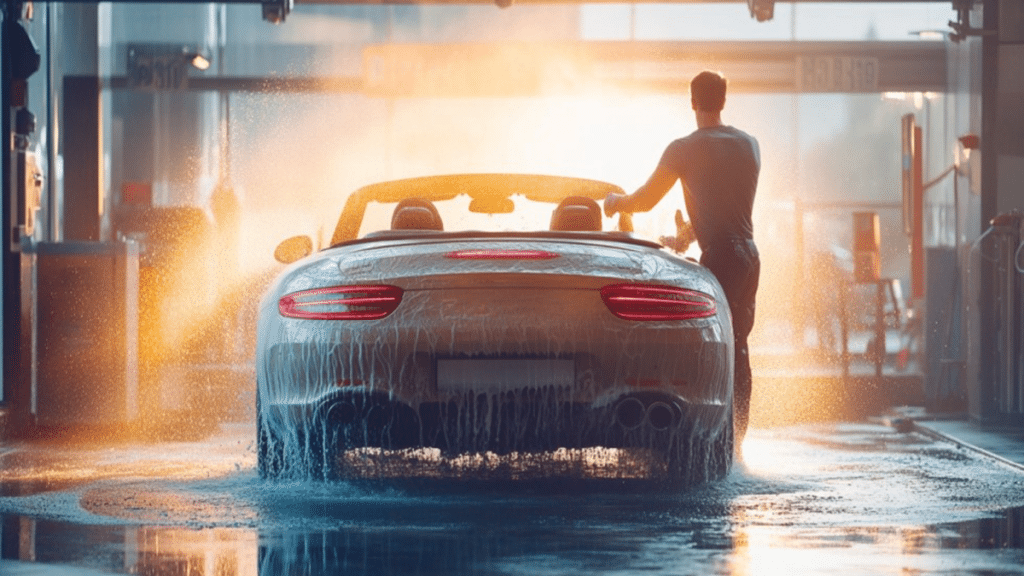We have all been there: after several rainy weeks, you pull back the cover, rejoicing in the first sunny day of spring, and there they are dreaded dark stains scattered across the soft top of your convertible top. Mold on the roof of your convertible top is not only unsightly but a real problem that can quickly compromise both the appearance and integrity of your beloved vehicle. But no reason to despair-we have lots of useful information on our site, and we have prepared this detailed guide for you concerning how to rid your soft top of mold and to keep your convertible top in perfect condition.
Why Mold Loves Your Convertible Top
Before we proceed with the solution, let us understand why your convertible top becomes a perfect breeding ground for mold. Think of your car’s soft top as a premium piece of outdoor furniture; it’s exposed to everything Mother Nature hurls at it. The fabric material, be it canvas or vinyl, has a penchant for retaining moisture, especially in damp conditions or following rain.
Put that together with a little organic matter-something as simple as a bit of tree sap, pollen, or bird droppings-and mold is in its element.
Warning Signs
San Diego-based classic car restoration specialist Sarah Martinez warns that mold can begin to grow long before it becomes visible. “If you open your car and it smells musty, or slight discoloration shows up as small dots,” she says, “that’s a warning sign to not ignore.”
Your Mold-Busting Arsenal
Before you start, round up the following essentials:
- Convertible top cleaner for your top’s material
- Soft-bristled brush
- Clean microfiber towels
- Rubber gloves
- Face mask
- White vinegar
- Spray bottle
- Clean water
- Convertible top protectant
1. Safety First
Remember that mold spores are very harmful to one’s health once inhaled. For this reason, try to work in a well-ventilated area and have protective gear on your body. “I have seen too many DIY enthusiasts skip the mask,” says Martinez. “Don’t make that mistake lungs will thank you later.”
2. Initial Assessment and Preparation
Park your car in a shaded area on a dry day. Go to the top and map out all the affected areas. Take photos if you need to – they will be helpful for you later in tracking your progress, so you can be sure you do not miss anything.
3. The Pre-Treatment
In your spray bottle, mix equal parts white vinegar and water. This is a natural solution to help neutralize the mold and make it less stuck onto the fabric. Spray the whole top, but really saturate the affected areas. Allow it to sit for 15-20 minutes, but do not completely let it dry.
4. The Deep Clean
And now, the pièce de résistance. Break out that convertible top cleaner, and follow the instructions on the bottle. More on that on the blog.
With your soft-bristled brush, gently work in small sections in light circular motions. “The key here is patience,” says John Cooper, a pro auto detailer. “You want to lift the mold, not grind it deeper into the fabric.”
5. The Rinse
Allow the top to run under plenty of clean water: this step is crucial because residual cleaning solution can render it a dirt magnet and even precipitate new mold growth.

Use your microfiber towels to blot- not wipe off excess water from the surface.
6. The Drying Process
This can be the most important step. When at all possible, allow your convertible top to air-dry in direct sunlight. “UV rays are a natural mold killer,” Cooper says. “Plus, proper drying prevents new mold from forming.”
7. The Protection Phase
When the top is fully dry, go over it with a good convertible top protectant. This creates a barrier against moisture and makes future cleaning a whole lot easier. Apply two thin coats, allowing each to dry completely.
Prevention: Your Best Defense
For most car care issues, it’s always better to prevent rather than cure. So, here are some pro tips that will help you in keeping mold at bay. These are as follows:
- Regular Cleaning: Don’t wait for visible dirt or mold. Clean your convertible top every 4-6 weeks during the active season.
- Proper Storage: If storing your car for extended periods, ensure the top is completely dry and use a breathable car cover.
- Quick Response: Immediately address any water exposure. After rain or washing, dry the top.
- Ventilation: Periodically open your car on dry days to allow for air circulation, even in storage.
When to Call the Pros
Although do-it-yourself mold removal typically is effective, there are times when you should call in a professional. “If the mold infestation is too severe, or if mold returns very fast after cleaning, then it’s time to bring in a pro,” says Martinez. “That could indicate a more serious problem with your top’s water resistance or sealing.”
The Cost of Procrastination
When it comes to mold on your convertible top, procrastination usually costs you money. Aside from aesthetics, mold can:
- Permanently discolor your fabric
- Weaken the structural integrity of your materials
- Leave behind long-lasting unpleasant odors throughout the entire vehicle
- Cause health problems for people with sensitivities
- Reduce your car’s resale value
A Fresh Start
Keep in mind that a mold-free convertible top is not just a matter of looks but also a protection of your investment and a way to ensure many happy years of open-top driving. With regular care and prompt attention to any signs of mold, you can keep your convertible-looking showroom fresh and ready for those perfect top-down days.
Be it a beloved classic or a luxury convertible with all the bells and whistles of today, these steps will keep that new look alive and well that stole your heart in the first place. Roll up those sleeves, gather your supplies, and get ready to give your convertible top the pampering it deserves. After all, there’s little to compare with the feeling of cruisin’ along on a great day with the top down and no moldy spots to be found.
